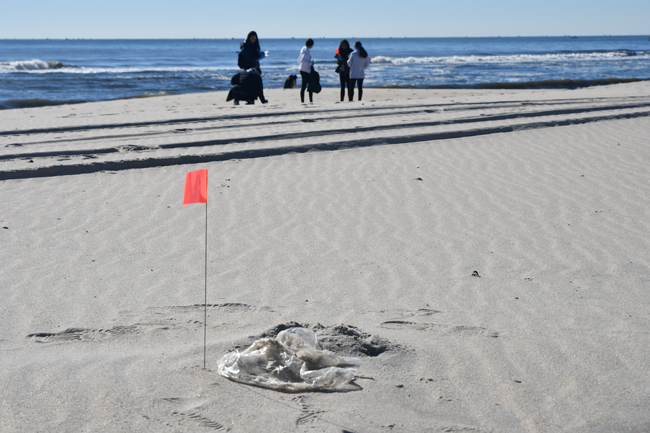NYSG programming is addressing the issue of harmful balloon debris through removal, outreach, and public awareness-building projects
Contact:
Krista Stegemann, NYSG Ocean & Marine Outreach Coordinator, P: 631-632-8730, E: ks2336@cornell.edu
Stony Brook, NY, March 4, 2019 - Through both removal and outreach programming, New York Sea Grant (NYSG) is collaborating on a project to address the issue of harmful marine debris, specifically balloon pollution, which is often the result of intentional releases by people who do not connect their actions to the debris problem.
Balloon releases are seldom associated with littering, but all released balloons eventually come down. Balloons and their remnants pose an extreme risk to marine animals, which can mistake them for food and ingest them, or become entangled in ribbons and attachments.
To address this issue, marine debris specialists from New York to Virginia are collaborating on a project led by MARCO (the Mid-Atlantic Regional Council on the Ocean) and funded by the NOAA Marine Debris Program. This project works to assess the quantity of balloon debris in the Mid-Atlantic coastal region and how and if that quantity may be impacted by outreach efforts. To assess the state of the problem in New York, baseline debris data is being collected through surveys and cleanup events. Balloons are a known problem in the Mid-Atlantic states, where 18,737 volunteers recorded more than 8,400 pieces of balloon litter during the 2016 International Coastal Cleanup.
In 2018, NYSG helped lead and oversee New York’s beach cleanup and balloon survey on Jones Beach in Nassau County. About 25 high school students from Kennedy High School and an additional eight volunteers from the local area and environmental organizations assisted in these tasks, learning about the topic of marine debris in the process. Over six hours, the effort covered one mile of beach, removing 2,204 pieces of debris, including 472 balloon-related items. These baseline numbers will be used with future data to assess the effectiveness of the project’s outreach efforts.
This project applies various outreach approaches. One area of attention is the acceptable social norms associated with intentional balloon releases. To begin to create change in this behavior, educational outreach is encouraging the use of alternative options to balloon releases.
This Balloon Debris Reduction Project is cleaning up New York’s coastline, collecting valuable data, and educating those that may unintentionally create balloon litter. This effort is focused on changing detrimental behavior and social norms in order to protect the marine environment and foster environmental stewardship.

High school students record debris items and mark balloon debris for data collection on Jones Beach in Nassau County, N.Y. Credit: NYSG/Krista Stegemann.
Partners:
• MARCO: Mid-Atlantic Regional Council on the Ocean
• New York State Department of Environmental Conservation
• New York State Office of Parks, Recreation and Historic Preservation
• NOAA Marine Debris Program (funding)
• U.S. Environmental Protection Agency
More Info: New York Sea Grant
New York Sea Grant (NYSG), a cooperative program of Cornell University
and the State University of New York (SUNY), is one of 33 university-based
programs under the National Oceanic and Atmospheric Administration’s
National Sea Grant College Program.
Since 1971, NYSG has represented a statewide network of integrated
research, education and extension services promoting coastal community
economic vitality, environmental sustainability and citizen awareness
and understanding about the State’s marine and Great Lakes resources.
Through NYSG’s efforts, the combined talents of university scientists
and extension specialists help develop and transfer science-based
information to many coastal user groups—businesses and industries,
federal, state and local government decision-makers and agency managers,
educators, the media and the interested public.
The program maintains Great Lakes offices at Cornell University, SUNY
Buffalo, SUNY Oswego and the Wayne County Cooperative Extension office
in Newark. In the State's marine waters, NYSG has offices at Stony Brook
University in Long Island, Brooklyn College and Cornell Cooperative
Extension in NYC and Kingston in the Hudson Valley.
For updates on Sea Grant activities: www.nyseagrant.org has RSS, Facebook, Twitter, and YouTube links. NYSG offers a free e-list sign up via www.nyseagrant.org/nycoastlines for its flagship publication, NY Coastlines/Currents, which is published quarterly. Our program also produces an occasional e-newsletter,"NOAA Sea Grant's Social Media Review," via its blog, www.nyseagrant.org/blog.